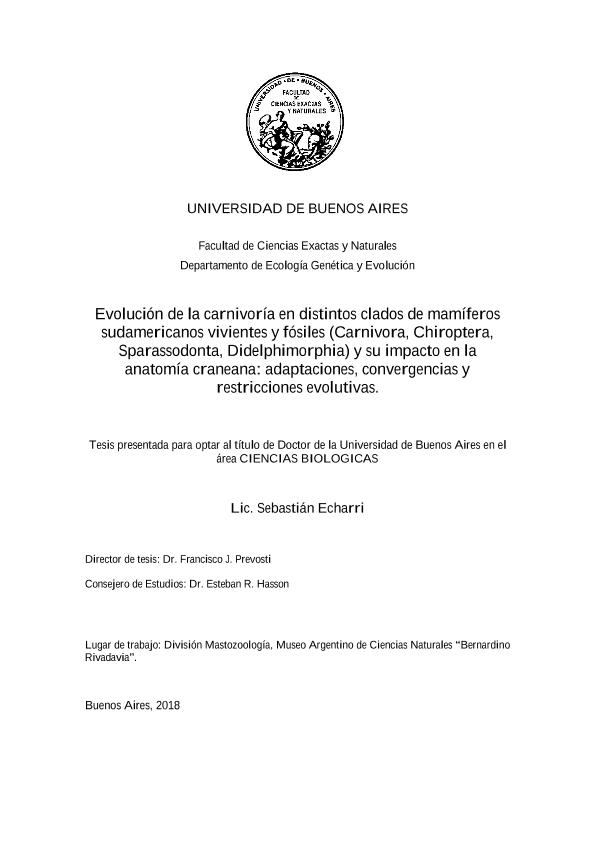Tesis doctoral
En América del Sur los metaterios han ocupado el rol de los grandes depredadores terrestres, cambiando esta situación con la formación del Istmo de Panamá y la consiguiente llegada de los carnívoros placentarios, que a lo largo del tiempo han tomado dicho rol. A su vez, los quirópteros es uno de los grupos de mamíferos placentarios más diversos y los únicos voladores, también se han adaptado a distintos tipos de dieta (como piscívoros, insectívoros, herbívoros, carnívoros propiamente dichos, hematófagos entre otros). Por otro lado el cráneo de los mamíferos ofrece gran cantidad de información sobre la dieta, relaciones filogenéticas y el comportamiento dado que está construido por complejos óseos. En este sentido hay gran cantidad de estudios que muestran la existencia de convergencias y restricciones evolutivas, principalmente entre Carnivora y Metatheria. En el caso de los murciélagos de hábitos carnívoros algunos autores han mostrado la existencia de convergencias con los representantes de Carnivora, en relación a hábito alimentarios en común. En esta tesis, mediante el uso de morfometría geométrica 3D, se ha encontrado que la forma del cráneo está principalmente afectada por las relaciones filogenéticas. Los hábitos alimentarios también tienen una relación con esta, aunque variando según el grupo, pero la mayor parte de la forma explicada por la dieta también está explicada por la filogenia, indicando que los hábitos alimenticios de estos mamíferos han cumplido un rol fundamental en la evolución del cráneo de estos mamíferos y sus linajes. In South America the metaterians have occupied the role of the great terrestrial predators, changing this situation with the formation of the Isthmus of Panama and the consequent arrival of placental carnivores, which over time have taken on this role. In turn, chiroptera is one of the most diverse groups of placental mammals and the only flyers, have also adapted to different types of diet (as piscivores, insectivores, herbivores, carnivores themselves, hematophagous among others). On the other hand, the skull of mammals offers a large amount of information about diet, phylogenetic relationships and behavior, given that it is constructed by bone complexes. In this sense, there are many studies that show the existence of convergence and evolutionary restrictions, mainly between Carnivora and Metatheria. In the case of bats with carnivorous habits, some authors have shown the existence of convergences with the representatives of Carnivora, in relation to common feeding habits. In this thesis, through the use of 3D geometric morphometry, it has been found that the shape of the skull is mainly affected by phylogenetic relationships. Feeding habits also have some relationship with this, although varying with the group, but most of the form explained by the diet is also explained by the phylogeny, indicating that the feeding habits of these mammals have played a fundamental role in the evolution of the skull of these mammals and their lineages.
Evolución de la carnivoría en distintos clados de mamíferos sudamericanos vivientes y fósiles (Carnivora, Chiroptera, Sparassodonta, Didelphimorphia) y su impacto en la anatomía craneana: adaptaciones, convergencias y restricciones evolutivas
Título:
Evolution of carnivory in different clades of extant and extinct South American mammals (Carnivora, Chiroptera, Sparassodonta, Didelphimorphia) and its impact on cranial anatomy: adaptations, convergences and evolutionary constraints
Echarri, Sebastián

Director:
Prevosti, Francisco Juan

Fecha de publicación:
28/03/2018
Idioma:
Español
Clasificación temática:
Resumen
Palabras clave:
Carnivora
,
Metatheria
,
Chiroptera
,
Morfometría geompetrica
,
Evolución
Archivos asociados
Licencia
Identificadores
Colecciones
Tesis(MACNBR)
Tesis de MUSEO ARG.DE CS.NAT "BERNARDINO RIVADAVIA"
Tesis de MUSEO ARG.DE CS.NAT "BERNARDINO RIVADAVIA"
Citación
Echarri, Sebastián; Prevosti, Francisco Juan; Evolución de la carnivoría en distintos clados de mamíferos sudamericanos vivientes y fósiles (Carnivora, Chiroptera, Sparassodonta, Didelphimorphia) y su impacto en la anatomía craneana: adaptaciones, convergencias y restricciones evolutivas; 28-3-2018
Compartir



